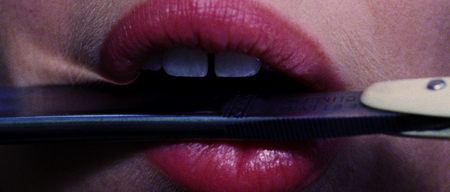[This is the first in a series of dispatches relating to the New Directors/New Films series, running between March 24, 2010 and April 4, 2010 at MOMA and the Film Society of Lincoln Center.]

Young filmmakers must start from somewhere. But if an excitable yeoman merely copies his masters (or “lesser” artists openly admired), can the new film be called original? It’s a question I’ve been pondering after seeing Amer, a feature-length homage to giallo with an aggressive sound mix, a commitment to crazed closeups and Ginsu-style cutting, and a panache for primitive semiotics that serve as crass conceptual catnip for wild-eyed film nerds. Yes, filmmakers Hélène Cattet and Bruno Forzani have demonstrated that they can mimic Dario Argento’s gel-centric lighting. They have paid attention to the way that Mario Bava has cut with cars and motorcycles. Like every film student on the planet, they have seen Un Chien Andeliou. But do they really have anything new or fresh to say? Not really. Amer essentially amounts to a one-note exercise predicated on an extremely silly worldview in which women must battle against relentless male leers and a neverending storehouse of internal sexual desire. This is certainly a cartoonish viewpoint reflected by giallo, but giallo, for all of its faults, at least permits us a few human moments within its pulpish framework. Amer, by contrast, contains such a preposterously intense energy that I’m not entirely certain that the filmmakers intended this as a parody.
Amer is so determined to bombard us with its ADD cutting style that we’re left to admire the style, but scoff at the crepe-thin substance. My bullshit detector pinged off the charts. Cattet and Forzani’s failure to stretch beyond mere homage, to back up their hungry energy with an offering that makes us feel something, is what ultimately makes this flick more of a calling card for Madison Avenue. This young duo would be more at home directing vacuous Calvin Klein commercials.
The film is centered around Ana, who is depicted here as a girl, a teenager, and a woman. Amer‘s early images, with Ana as the girl, are the most promising. There are numerous eyes in extreme closeup — spastic pupils peering through keyholes, eyes contained in jewelry, and a dead man’s eyes that won’t stay shut. Mysterious glass shards are found beneath a bed. There’s a trunk bundled with limitless dolls. Viscous fluid, which we later learn from a ridiculous bathtub masturbation scene is of a magical realist and sexual nature, rains down on Ana as she attempts to navigate through a decaying palazzo laden with endless horrors, including some creepy figure in a black veil. Given all this imagination, we expect some motivation, something that extends beyond facile formalism. At this early point in the flick, Cattet and Forzani had me spellbound. I was eager to escape into this imaginative world. Until I became very aware that this was little more than a Suspiria knockoff. Then the images began to stretch horizontally, eventually moving into the next sequence of Ana as a teenager, walking along a road and holding her mother’s hand. The camera continued to objectify the young woman’s body with extreme closeups. Diaphanous outlines of her body contained in a purple skirt. The mother undoing her top button. Little dialogue. Yeah, I get it. Here we have a one-dimensional woman to be ogled by the camera. A knowing tribute to exploitation in which sequences are needlessly padded out. (Indeed, one scene involving a walk through the woods, in which various branches grope at Ana’s clothes as a battered shutter is banged about by the wind, proved so interminable that I wondered if I should slip into the restroom and relieve myself.)
Did this really need to be feature length? With all the frenetic cutting, I began to feel very sorry for the actors, who surely could not have had much to contribute to a film featuring few shots longer than a second. Indeed, the film’s editing proved so rapid-fire that it made Tony Scott look like David Lean.
And all this for an homage to giallo, complete with Stelvio Cipriani music cues. But why bother with the copy when there was the great life within the original? And why go to the trouble of making a movie that merely served to repeat, but that wasn’t willing to give us even a minimal human moment?
Homage is a tricky tightrope. As Peter Bondanella has observed in his book-length overview of Italian cinema, Pasolini’s early films paid homage to an early neorealist heritage. Classical art and music accompanied Pasolini’s gritty depictions of downtrodden criminals, and this juxtaposition, predicated upon the triumphant proletariat, permitted Pasolini to later get in touch with the personal and more daring style that he is known for today. But what Pasolini was doing with such films as Accattone and The Gospel was hardly muddled mimesis. Accattone‘s titular hero, for example, emerged as an inverted Christ figure, with the class trappings replaced by oppressive religious forces. These larger concerns allowed Pasolini to escape the mimetic yoke and emerge as an unforgettable filmmaker.
But I felt no such promise with Cattet and Forzani. These are hollow technicians who have seen too many films. Artistic vessels who don’t seem even remotely interested in what it is to be human. I longed for the likes of György Pálfi. But they’ve managed to con the festival circuit with their empty spectacle. Film geeks will rejoice. The rest of us hang our heads in disappointment.